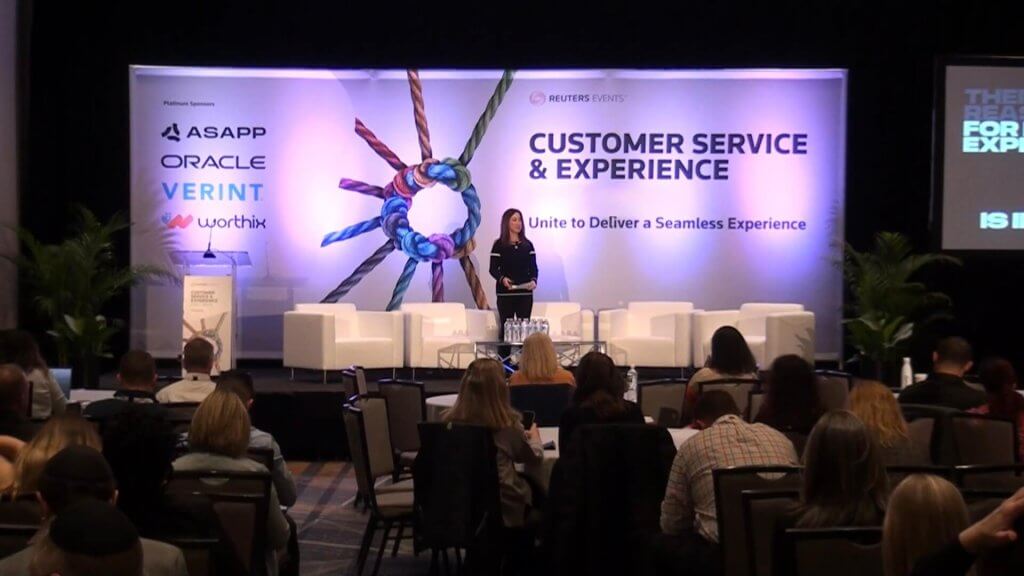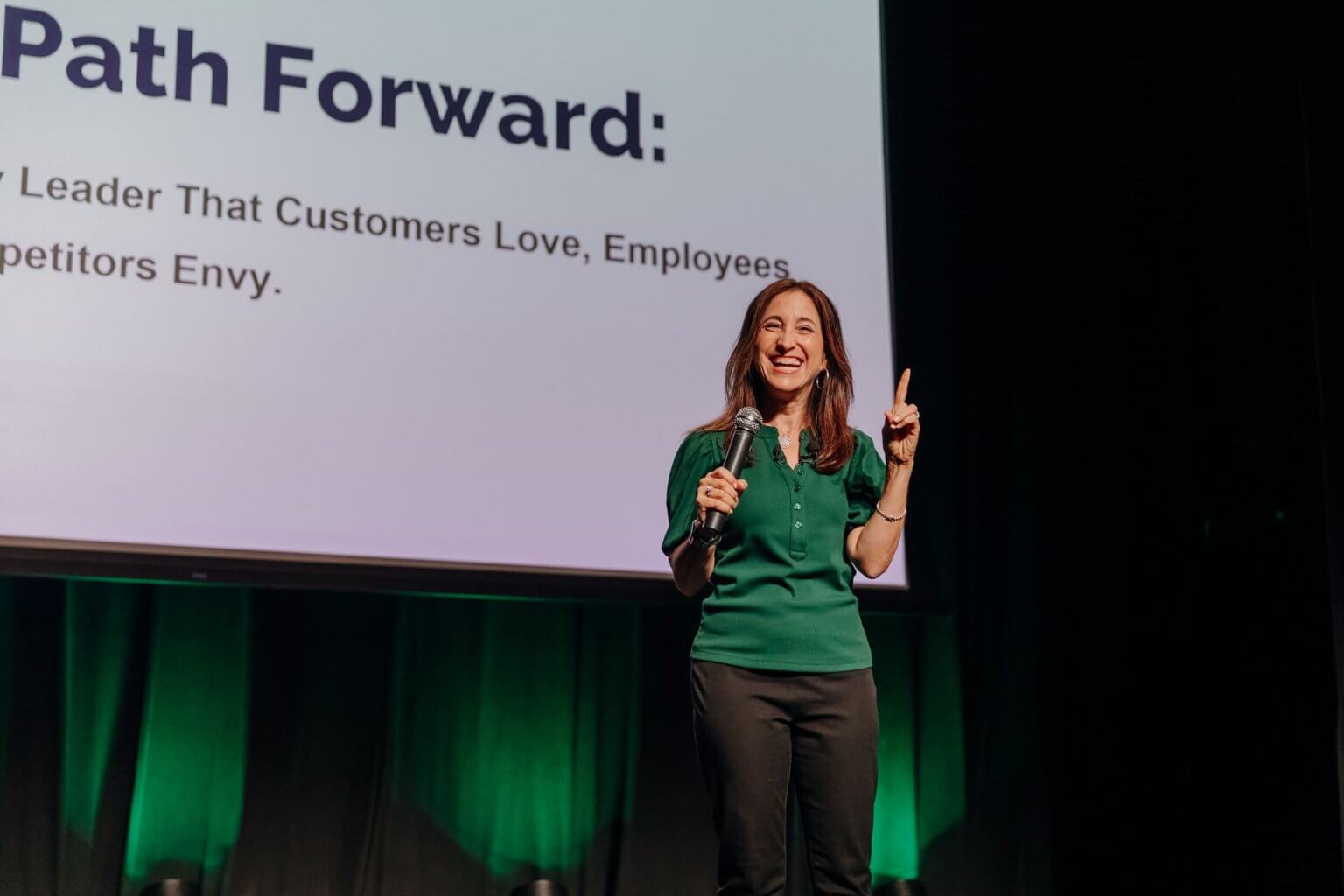Every interaction a customer has with your brand is a chance to build loyalty or risk losing it. Yet most companies struggle with doing CX right, aligning teams around a consistent, meaningful experience. Research shows 86% of buyers are willing to pay more for a great experience, but only 1 in 3 feels brands deliver consistently (PwC).
In this interview, Stacy Sherman, founder of Doing CX Right®, shares insights from her 25-year career. She explains how to bridge the gap between leadership intent and customer reality and offers practical strategies to rally teams, design intentional experiences, and use empathy and data to drive loyalty.
The person behind the “Doing CX Right®” brand
Q: You’ve spent 25 years in CX—can you share what first drew you to focus on building authentic connections between people and brands?
I earned my MBA in Marketing while working at AT&T, which allowed me to apply academic knowledge to real-world work. I continued doing that while moving into a variety of corporate roles.
What I noticed while shifting from sales to marketing and working across departments was that everyone had different priorities: some people focus on expense reduction, others on revenue, and a few on the customer. But rarely was the customer at the center for everyone.
I saw the opportunity to be the glue across departments, rallying everyone around a single priority: putting the customer first.
At first, it started out as customer service, but in reality, it was about customer experience, looking at it from marketing, HR, product, and other business lines. Eventually, I moved into a dedicated customer experience role to bring together all teams across the organization. And that's the evolution of my career.
Q: When you talk about “Doing CX Right®,” what does that mean from your perspective?
When I say Doing CX Right®, it means creating an intentional experience in how people interact with your brand from the moment they learn about you, purchase, receive your product or service, use it, pay, and get help (traditionally called customer service). It’s about designing each of those micro experiences internally, ensuring consistency across all journey points, and measuring results.
But internal design isn’t enough; you must validate with real customers to confirm it meets their needs. And when it doesn’t, bring teams back together to fix the pain points. This is an ongoing process because customer needs continuously change, especially in an AI era.
Balancing multiple roles in CX
Q: Your career spans speaking, podcasting, teaching, and consulting. How have you balanced all these roles while continuing to make a meaningful impact in CX?
I am super organized and very disciplined. I also educate people on time management - how to spend your time productively, not just your definition, for the people you serve and love, like your family and work. It's really a strategic way of time management to get everything done.

What are the key principles of doing CX right?
Q: You often say that exceptional CX doesn’t require huge investments. What are some low-cost, high-impact strategies that companies frequently overlook?
A lot of times, people think they have to invest in sophisticated technology to serve their customers better. But studies show that many companies actually have too much technology, and the systems aren’t even talking to each other. That creates data silos, and human silos too.
That’s why I always say: be intentional and careful about what technology you bring in. Artificial Intelligence (AI) only creates value when it strengthens relationships; otherwise, it’s just another system adding complexity.
Humans are the ones who can really improve both the customer experience and the employee experience.
Why introduce AI into customer experience
AI can be a powerful tool when applied with purpose. For example, you can use AI, paid or free platforms, to analyze structured surveys, unstructured reviews, website content, and social media chatter. It helps uncover key pain points and customer sentiments, including the emotional highs™ and lows, so you can clearly see where to improve.
This doesn’t have to be expensive. Even simple tools like ChatGPT can highlight common complaints when you feed in anonymized data. (Check out Stacy’s short video explainer)
Leading with heart and science
Q: One of your core ideas is the “both/and” principle—leading with heart while achieving financial goals. Can you explain how that works in practice?
When I talk about heart and science, the “heart” is really the human element: the sentiments, the empathy, the core principles of listening to customers and understanding how they feel. The “science” is taking the data and combining it with human insight to really understand your customers and design the experience.
And design is the keyword here. Customer experience doesn’t happen automatically. It's a thorough, intentional design where you sit with your teams and map out exactly what experiences your customers have: how they learn about you (typically via marketing). The typical route goes “learn” → “get” → “use” → “pay” and “get help.”
I want to emphasize something about the “pay” stage. I often tell finance people: they think they don’t have a customer experience role. But they do. If the first part of the journey goes smoothly, but paying a bill or getting a question answered is frustrating, the beginning of the journey doesn’t matter.
How can any employee influence customer experience?
Q: You’ve mentioned that sustainable success is impossible without making CX accountability a shared priority. How can employees in roles outside of CX still influence customer experience and loyalty?
In my keynote speeches, I talk about how everyone, from the CEO to interns and everyone in between, has to be accountable for the customer experience. Often, people in HR, IT, or other departments, aside from CX leaders, react to customer problems with “that’s not my problem.”
What I focus on when I work with clients and speak from the stage is helping everyone understand that they do have a customer experience role. It’s more than just being responsible for your business lane or project. It's about being accountable for the experiences customers see, feel, and remember. I want people to realize that customer experience is bigger than their individual role; it’s about taking that accountability.

The power of journey mapping and seamless handoffs
A lot of times, people say, “I don’t really own that function; this is my job.” When you do journey mapping, people see the domino effect of where their role begins and ends, and how it leads into their teammate’s areas of focus. This makes the customer’s experience seamless.
Measuring Emotional Highs™ in CX
Q: How can organizations identify Emotional High™ moments in the customer journey and use them to drive loyalty and positive behavior?
I have this belief that companies are still measuring customer experience in an old-fashioned way: Net Promoter Score, CSAT, and others. If you haven’t been measuring CX, that’s a great place to start, but don’t stop there. Even if you have a really thorough CX practice, it is absolutely time to go past that. I'll debate anyone who says customer satisfaction alone isn't enough.
Turning frustration into positive customer moments
Think about it: if I finished a conversation with you and told a friend, “Yeah, it was fine, I was satisfied,” is that really memorable? Is that exceptional? Would I want to come back and engage again? Probably not. “Fine” is not “wow.”
That’s why I focus on measuring Emotional Highs™, the moments when someone feels valued, important, and sees discretionary effort from your team. Those moments matter because they have a compounding effect.
The flip side is true, too. If you’re creating emotional lows, frustration, friction, or anger, you need to measure that as well and turn it into highs. It’s a very methodical approach.
Doing CX right through the podcast and LinkedIn Learning
Q: Your Doing CX Right® podcast has gained global recognition. What inspired you to start it, and how do you choose topics and guests that truly resonate with listeners?
I started in 2017 with a blog called Doing CX.I wrote articles not knowing if anyone would read them, but they did. And that ignited me to continue sharing my views globally and ultimately win multiple awards. While working full-time at a telecom company, I shared my views as a hobby, which led to great conversations.
After being a guest on 50 podcasts, I decided to host my own, using it as both research and relationship-building. In 2023, I took everything I’d built over 25 years in corporate roles and started my own company. That’s when the podcast really accelerated in success, because I was no longer restricted by being in a corporate environment.

The core idea is always: How do you improve people’s experiences and enhance lives even in an AI world? There’s no reason for bad experiences. There are simple actions every person can take.
It’s evolved since the beginning, and it keeps evolving. I never run out of content.
Key takeaways from LinkedIn Learning courses
Q: You also teach LinkedIn Learning courses. What are the key takeaways you hope students put into practice immediately?
- Loving the Ones You Have™: they’re the ones who grow your business. Your existing customers can be your best marketing channel.
- Design the customer experience, bring people to the table, and methodically map it out. Validate it with real customers to confirm it’s what they want, then fix the gaps.
- Fix communication breakdowns: marketing says one thing, the customer gets an offer, and then something goes wrong, like they can’t use a promo code at checkout. They call customer service, and the agent has no idea what offer they’re talking about. Same with chatbots; when it finally connects to a human, the human has no idea what the bot covered.
- Elevate agent experience: The training and recruitment are expensive, and there are many great agents out there. How do you keep them motivated? They’re your front line. How do you prevent turnover and protect the investment you’ve made in training them? How do you enable them to build stronger relationships with customers? That course is really for customer service leaders. Agents play such an important role, and I always emphasize that.
AI, automation, and human-centered CX
Q: How do you see AI and automation coexisting with human-centered experiences without losing empathy and connection?
One of my favorite use cases is that humans can’t possibly read every comment a customer, prospect, or detractor makes. There’s too much: surveys, social media, and other feedback. Technology can aggregate, centralize, and prioritize all the pain points and positive feedback, allowing you to make business decisions from it.
Secondly, I love technology that helps humans build confidence. In customer service, sales, or any frontline role, agents can practice on a simulation before talking to a real customer. The technology acts like a customer; it can be angry, calm, or display different personalities.
The human trains with the simulation, practices repeatedly, and can share sessions with their manager for evaluation. Once they’re confident, they’re ready to talk to a live customer. This is technology supporting humans, and it’s a great use case.
Pitfalls to avoid when bringing automation into customer experience
Q: What pitfalls should companies avoid when integrating AI into CX without losing empathy?
One example is when I worked at a contact center, a BPO. Agents were doing their best to answer customer questions on the spot. They were measured for quality, but also for speed, “get off the phone”, which is another topic.
They had a library of content to help answer questions on calls, chats, or bot conversations. But even with technology, if that library isn’t updated, if product teams, marketing, and others don’t provide accurate answers, the agents end up with outdated information, and the customer experience suffers.
They won’t get helpful information, and that’s a major pitfall. It can deflate the agent or salesperson, affect their credibility and trust, and give the customer a negative “moment of truth” that shapes their opinion of the brand.

Actionable tips for employees to start doing CX right
Q: Finally, what’s one actionable tip that any employee—regardless of their role—can implement today to influence CX?
One easy step is this: go to your meeting tomorrow and bring customer feedback (from surveys, call listening, or comments on social media).
Give that feedback to your marketing team and ask them to respond to the customer; tell them, “Here’s what we’re going to do because you left that feedback.” Closing the loop is very powerful and easy to do.
Even if you’re in Finance or HR and think, “I don’t have a customer experience role,” you do.
Bring cross-teams together and map out the entire customer journey from beginning to end. Define how do our customers learn about us? How do they buy, get, use, pay, and get help?
If customer experience improvements aren’t happening, go be a change agent. Rally teams together to fix customer pain points. Don’t wait for formal permission, explain why CX matters and use data to justify. Start with the low-hanging fruit, then move into the harder fixes.
Everyone Must Be Accountable for the Customer Experience
Doing CX right starts with simplicity, consistency, and action. Stacy Sherman shows that putting the customer at the center and rallying cross-functional teams leads to meaningful results. Designing customer experiences has to be intentional. It doesn’t happen automatically.
Stacy emphasizes that every employee, regardless of role, can influence the customer experience. Doing CX Right® transforms insights into action, strengthens teams, and drives measurable business outcomes without huge investments. Most importantly, you can start Doing CX Right® now. Don’t keep thinking, hoping, or waiting. It’s the doing that brings results.



